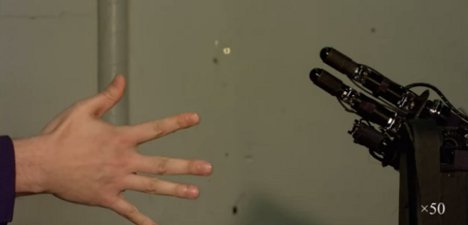 |
| An insect fitted with piezoelectric generator to harness the energy from the insect's wing. |
Insects have served as the inspiration for a number of Micro Air Vehicles (MAVs) that could be deployed to monitor hazardous situations without putting humans in harm's way. Now researchers at the University of Michigan College of Engineering are proposing using actual live insects enhanced with electronic sensors to achieve the same result. The insect cyborgs would use biological energy harvested from their body heat or movements to potentially power small sensors implanted on their bodies in order to gather vital information from hazardous environments.
To harvest energy from insects, the researchers have designed a spiral piezoelectric generator that converts the kinetic energy from the insect's wing movements into electricity. This power would be used to prolong the battery life of devices implanted on the insect, such as a small camera, a microphone or a gas sensor. The prototype piezoelectric generator was fabricated from bulk piezoelectric substrates and was designed to maximize the power output in a limited area.
"Through energy scavenging, we could potentially power cameras, microphones and other sensors and communications equipment that an insect could carry aboard a tiny backpack," said Professor Khalil Najafi, the chair of electrical and computer engineering at the U-M College of Engineering. "We could then send these 'bugged' bugs into dangerous or enclosed environments where we would not want humans to go."
The U-M team examined several techniques to scavenge energy from wing motion with their results were published in a paper titled "Energy scavenging from insect flight," which was recently published in the Journal of Micromechanics and Microengineering. The university is now pursuing a patent for the technology and is seeking commercialization partners to bring it to market.
Getting the insects to go where their handlers want them to is another part of the puzzle that needs to be solved before insect cyborgs can be deployed. But DARPA has been working on this, having put out a call some years back for research proposals for Hybrid-Insects-Micro-Electro-Mechanical System (HI-MEMS) interfaces to control the movement of living insects. Combining the two technologies could be just the thing to take insect cyborgs to the next level and see them used to monitor hazardous situations in the not to distant future.
sources : http://www.gizmag.com/insect-cyborgs/20596/
The U-M team examined several techniques to scavenge energy from wing motion with their results were published in a paper titled "Energy scavenging from insect flight," which was recently published in the Journal of Micromechanics and Microengineering. The university is now pursuing a patent for the technology and is seeking commercialization partners to bring it to market.
Getting the insects to go where their handlers want them to is another part of the puzzle that needs to be solved before insect cyborgs can be deployed. But DARPA has been working on this, having put out a call some years back for research proposals for Hybrid-Insects-Micro-Electro-Mechanical System (HI-MEMS) interfaces to control the movement of living insects. Combining the two technologies could be just the thing to take insect cyborgs to the next level and see them used to monitor hazardous situations in the not to distant future.
sources : http://www.gizmag.com/insect-cyborgs/20596/







